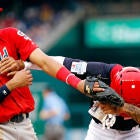Reminder: MLB should do better with the Futures Game instead of burying it on the final day of the first half
The game is buried on a Sunday at 4 p.m. ET/1 p.m. PT while 15 MLB games are in progress
WASHINGTON D.C. -- We discussed this last year and it still applies, so let's have the same conversation. I'm sitting here at the Futures Game in Nationals Park, watching the next generation of star baseball players on a beautiful Sunday afternoon.
The Futures Game kicks off the All-Star break fun each year on Sunday, letting us appreciate the best players in the minor leagues with a USA vs. World format on a big stage.
The first Futures Game was in 1999, when Yankees prospect named Alfonso Soriano won the game's MVP. We know him, right?
How about Mike Trout, Bryce Harper, Alex Bregman, Aaron Nola, Jose Altuve, Jesus Aguilar, Aaron Judge, Manny Machado, George Springer, Francisco Lindor, Luis Severino and Javier Baez? We know them, too!
The idea is clear here, but let's slap a number on it: 170.
There have been 170 players who took part in the Futures Game go on to make an MLB All-Star team. This season, there are 16 first-time All-Stars who took part in the Futures Game. It's now an average of around nine players from each Futures Game who eventually became All-Stars. Almost all of those who never make an All-Star Game still end up being useful players in the show.
Simply, it's a worthwhile showcase of the next generation of great baseball players. Some of these guys will be superstars while others will be important everyday players.
Still, it's pretty well buried by MLB. I said earlier it kicks off the All-Star fun, but in a way that's not actually true. When the game started Sunday at 4 p.m. ET on the MLB Network, it came in the midst of a full slate of MLB action. All 15 MLB games were day games on Sunday. TV ratings data shows that MLB fans are pretty regional, in that they really only watch their favorite team until the playoffs. Do the math. The overwhelming majority of MLB fans Sunday were watching the big-league product instead of tuning in to see the minor leaguers.
Fans who did tune in or attend the game -- it wasn't a big crowd, as I'd estimate Nationals Park was a little more than half full but likely not 2/3 -- saw some very exciting things.
In the second inning, Seuly Matias (Royals prospect, Class A) homered to right. It shouldn't be too surprising, considering he's hit 26 homers in just 268 at-bats this season.
.@Royals prospect Seuly Matias leads @MiLB with 26 homers.
— MLB (@MLB) July 15, 2018
He’s showing off that power in D.C. pic.twitter.com/TApOFk5xZD
In the top of the third, top Reds prospect Hunter Green (Class A), who has 80 strikeouts in 63 1/3 innings this year, was wowing the crowd with 102 mile-per-hour fastballs ...
1️⃣0️⃣2️⃣@HunterGreene17 is bringing the 🔥. pic.twitter.com/PgbiIxa66Y
— MLB (@MLB) July 15, 2018
... until Luis Basabe (White Sox, Double-A) turned one around with a majestic shot to right-center.
We got to see hard singles off the bats of some familiar names in Bo Bichette (Blue Jays, Double-A) and Fernando Tatis, Jr. (Padres, Double-A).
Catcher Danny Jansen (Triple-A, Blue Jays) went yard to tie the game at three in the bottom of the fourth. Later that same inning, Ke'Bryan Hayes (Pirates, Double-A) destroyed a two-run shot over the left-center field bullpen. He's Charlie Hayes' son! That's fun.
Yusniel Diaz (Dodgers, Double-A) homered in the fifth. Carter Kieboom (Nationals, Double-A) flashed some nice range at shortstop. Diaz homered again to tie it in the seventh. In the bottom of the seventh, USA pulled back ahead by three, thanks in part to a huge blast off the bat of Peter Alonso (Mets, Triple-A).
Taylor Trammell (Reds, Class A) also homered for the US in this one.
It was an incredibly-entertaining baseball game played by the next generation of MLB superstars.
These kids deserve a much-bigger stage than what they're getting.
Sure, the die-hard prospect fans are going to tune in -- what percentage of fans is that, by the way? -- but MLB could give these guys a larger platform by playing the game unopposed.
Since I'm a solutions-oriented guy (don't bring up a problem unless you propose at least one solution), let's discuss some alternatives.
What if the final MLB games of the first half were played on a Thursday, the Futures Game goes on a Friday night with big league All-Stars in the house, the Home Run Derby takes place late Saturday afternoon and the All-Star Game is in the Sunday night time slot that is a big TV ratings spot? Then MLB action could resume on the following Tuesday. Changing the tradition that much might really scare off a lot of people, though. There's an easier option.
With there being no night game this Sunday, there's an easy solution sitting right in front of our faces. Make the Sunday night showcase this Futures Game. Now there are more available eyes tuning in to see what prospect of their favorite team is playing.
There needs to be a solution. The Futures Game is fun. It's a good place to get fans, especially those of non-contending teams, excited about some excellent and incredibly-young talent.
Instead, it's buried in front of a nearly-half-empty stadium on a Sunday afternoon while there are 15 games of actual Major League Baseball. It's a dropped ball and doesn't do justice to the kids out here.


















